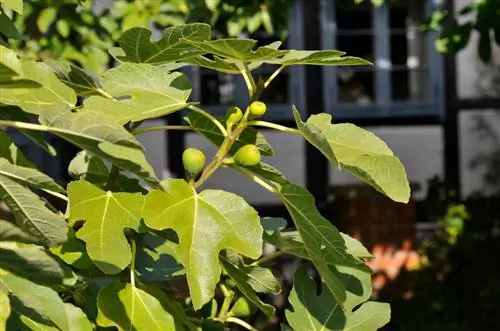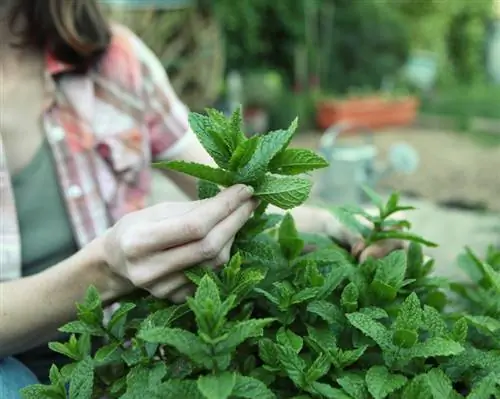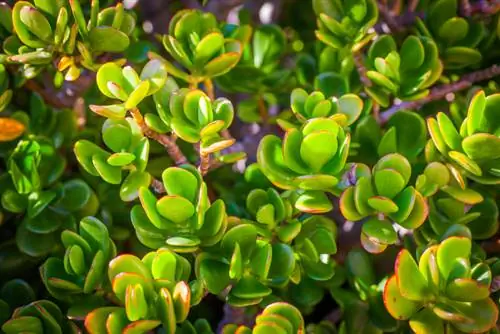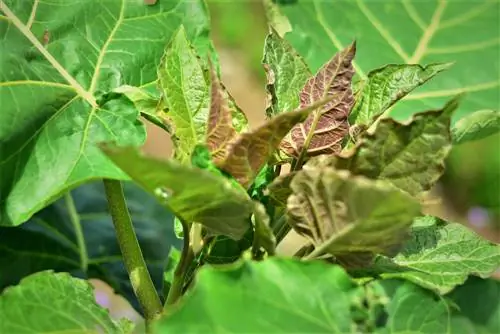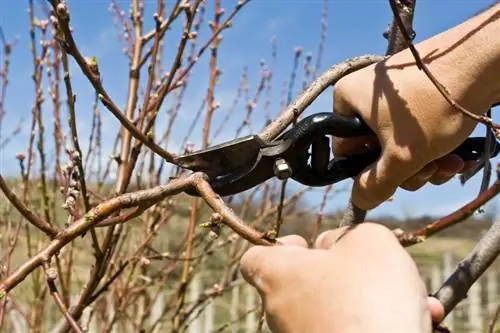- Author admin [email protected].
- Public 2023-12-16 16:46.
- Last modified 2025-06-01 06:02.
Sweet home-grown figs trump fruits from the store shelf in terms of taste and quality. Reason enough for your own fig tree in a bed or pot. One of the key functions for a rich fig harvest is expert pruning care. This tutorial will familiarize you with the correct pruning method for vital fruit wood, which will give you fresh figs up to twice a year.
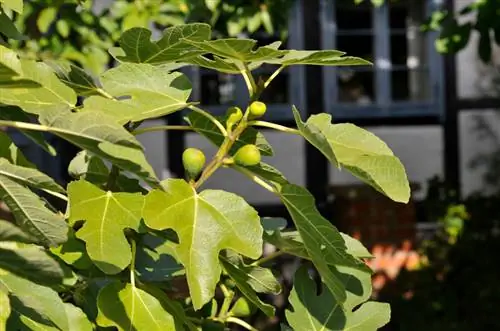
How do I prune a fig tree correctly?
To prune a fig tree, remove dead or unfavorable wood in February/March and encourage fresh fruiting wood. A distinction is made between training pruning, maintenance pruning, summer pruning and rejuvenation pruning. The goal is light-flooded growth and a rich harvest.
Prune the fig tree annually - cutting options
Modern fig varieties are also hardy north of the Alps. Particularly in regions with mild winters, such as on the Lower Rhine or in wine-growing regions, figs thrive as a richly branched shrub or small tree in the bed. Where the temperature drops below -10 degrees Celsius in winter, the Mediterranean fruit trees as container plants provide sweet fruit enjoyment. A careful choice of location and adequate wintering alone are not enough for an annual fig harvest. The expert cut guarantees that your Ficus carica remains vital and blooming with a high proportion of fruit wood. The following table summarizes which cutting options you can use to achieve your goal:
| Cutting types | Goal/Occasion | best date |
|---|---|---|
| Educational Cut | build a harmonious crown, promote fruit wood | February to early March |
| Conservation cut | Remove dead, unfavorable shoots, promote light-flooded growth | February to early March |
| Summer cut | Promotion of overwintering fruit plants | End of July to mid-August |
| Rejuvenation cut | revitalizing neglected fig tree | late winter |
Treating the fig tree correctly
Traditionally, home gardeners north of the Alps cultivate a fig tree as a sprawling, richly branched shrub. At least in mild winter regions of winter hardiness zones 7 and 8, the fruit tree as a planted shrub produces a plentiful fig harvest in August and again in October. If the garden is located within harsh hardiness zones 5 and 6, a fig tree thrives in a container to spend the cold season behind glass. Under these conditions, training a small tree with a short trunk and a stable crown proves to be advantageous. Consider this recommended option, trim a young fig like this:
- On the day of planting: Leave the middle shoot standing, cut off the remaining ground shoots at the base
- Up to the desired trunk height: Raise the central shoot on the support rod, do not shorten it, remove side shoots regularly
- Crown formation: Cut off the top bud of the central shoot, at least 4 buds above the base of the crown
As the illustration below shows, a fig tree should be trained with a short trunk and a crown of trunk extensions and four side shoots. It is crucial for trunk training and crown building that you only cut the top bud when it is 4 to 6 budsabove the desired crown base. If you cut the top bud too early, height growth will come to a standstill and your fig tree will remain puny.

Train a fig tree in a pot and in a bed with a short trunk and a pyramidal crown. Decorative and flooded with light, the crown thrives with a dominant central shoot, around which four lateral branches gather to form a framework. The crown framework supports the annual fruit wood.
Excursus
Escaping milky juice causes itching and allergies
Under its smooth, gray bark, a fig tree is suffused with milky sap. Direct contact of milky sap with the skin under sunlight can cause photodermatitis. The allergic reaction manifests itself as severe itching, followed by blistering and eczema. In contrast to sunburn, affected skin areas heal slowly and are characterized by irreversible pigmentation. Therefore, wear gloves with long cuffs when carrying out any cutting work.
Preservation cutting - step-by-step instructions
As a shrub or tree, the fig thrives with along-lasting frameworkof ground shoots or crown branches. The framework supports theshort-lived fruit wood with inconspicuous flowers. The tree blooms on previous year's shoots in March and produces the longed-for fruits from August. Greenish flowers appear on this year's wood in July, only to turn into figs in the fall. Annual maintenance pruning aims to ensure light-flooded growth and the promotion of young fruit wood. The following incision has proven to be excellent in practice:
- Cut off dead wood at the base
- Cut back frozen side shoots on the framework to short stubs of 5 to 10 centimeters
- Cut out the weaker one from two parallel vertical shoots
- Cut inward-facing branches back to one or two outward-facing buds
A flawless maintenance cut leaves behind a stable, load-bearing framework with vital fearwood. Dead shoots from the previous year ideally remain uncut because they produce the first harvest in late summer. However, if a shoot from last year has reached a length that could cause it to break under the weight of fruit this year, as an exception, cut the branch by a third or half. Perennial wood is shortened to a few buds from which this year the fresh fruit wood will sprout, which will produce juicy, sweet figs in autumn and again next summer.

Maintenance pruning brings order to the branches. Thin out dead, frozen or criss-crossing shoots. Previous year's side branches remain standing because they bear valuable flower buds for sweet figs in August.
Promoting fruit wood - this is how it works
If a shoot has borne fruit for two or more years, it degrades significantly. Old fruit woodcan be identified by dense branching anddrooping growth This appearance does not mean that you can finally declare the branch to be “old iron” and completely thin out. As long as it has an unbranched, one-year-old shoot in the rear area, an advantageous fruiting woodcut is suitable at this point.
As shown in the illustration below, place scissors or saw where the young fruit wood branches diagonally upwards. Please place the cutting point a few millimeters into the old wood so as not to injure the young side shoots. The stub should not be longer than one centimeter, otherwise the resulting rot could result in the risk of disease.
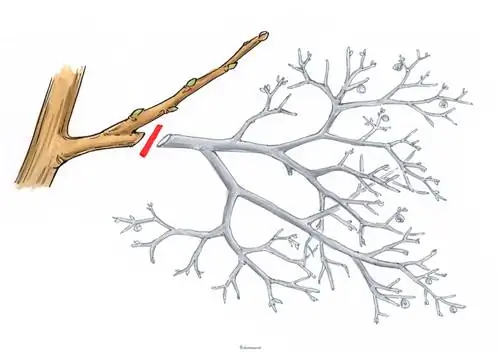
A fig tree bears the most delicious fruit on annual, slanting upward side shoots. Cut off worn, massively branched wood where a young shoot with buds branches off.
Summer cut
A lightSummer pruningThe following pruning is intended for and aims atplanted figsFor a vital fig tree and fruits in premium quality to prevent the strenuous growth of defective autumn fruits. In return, the production of overwintering fruit plants is supported for an early harvest of the best quality. How to do it right:
- Best time is late July to mid-August (after the summer harvest)
- Examine the bush or crown carefully for breeding birds in order to reschedule the appointment if necessary
- Cut all of this year's unbranched side shoots back to 6 to 8 leaves
As a result of the summer pruning, the remaining flower buds form rudimentary fruit systems that overwinter and become ripe figs the next summer.
If it is a fig in a pot that overwinters behind glass, there is no summer pruning. The flowers in July turn into figs, which still ripen in the bright, warm winter garden.
Background
What exactly is fruitwood?
Pruning figs is all about promoting and preserving fruit wood. By definition for fruit trees of all kinds, fruit woodnotis the wood from which thelong-lasting basic structureis formed for the shrub or tree crown. Rather, the term refers to rather short-lived side branches. In the specific case of a fig, the most vital fruit wood comes from theprevious year and this year The easiest way to identify young fruit wood is by its sloping to horizontal and few-branched growth. Older side shoots on the supporting framework hardly bloom and bear fruit. The declining vitality can be clearly seen in massively branched, drooping shoot tips.
Rejuvenation cut
The remarkable pruning tolerance of a fig tree is based on its ability to produce fresh shoots from old wood. The floral feat succeeds because the plant creates numerous sleeping eyes beneath the bark as it grows. The tiny, almost invisible points of vegetation are just waiting to replace lost branches or trunks. You can build on this “iron reserve” if you revitalize an aging or neglected fig tree with a rejuvenating cut. How to do it professionally:
- The best time is during the leafless winter period
- Cut back frozen branches to he althy wood
- Cut off dead wood at the base
- Remaining branches divert to a lower, outward-facing side shoot
Many branches of planted figs can freeze back completely in a harsh winter. The long-lasting framework of thick, perennial branches is usually not affected by the damage. If you are unsure whether there is still life in a shoot or not, a vitality test eliminates any concerns. Scrape off some of the bark with a knife or fingernail. Alternatively, cut off a small piece of shoot. If juicy, cream-colored to green tissue emerges, life is pulsating in the shoot. Brown tissue, on the other hand, leaves no doubt that you are dealing with dead wood that needs to be cut out.
Frequently asked questions
Our fig tree is now two years old. It grows continuously and has now reached a height of two meters, unfortunately without any side shoots. New shoots are now sprouting from the tree disc. Should we shorten the trunk?
Please decide on a suitable trunk height, for example 150 centimeters. At this point, cut the stem about an inch above a bud. Below the interface, side branches begin to grow, which form into the future crown. The shoots from the tree disc compete with the crown for nutrients and should be removed promptly.
We took over a fig tree from our neighbor and now want to transplant it into our garden. When is the best time? What should you pay attention to?
The best time to change location is after the leaves fall in autumn. Use the spade to cut off the roots all around in a large radius. Root strands that are torn off rarely grow back. Choose a sunny location with loamy, slightly acidic soil that is well-drained and rich in nutrients. We recommend enriching the soil with rhododendron soil. In February/March, cut the shoots back by a third to compensate for the lost root mass.
How big should a pot be for the fig tree? How high can a Ficus carica reach in a pot? Can I cut back the branches for bush-like growth?
If the nursery supplies you with a young fig tree with a height of 80 to 100 centimeters, you will need a bucket with a volume of 40 to 50 liters. With sufficient water and nutrient supply, the plant can reach a height of up to 3 meters. The pronounced pruning tolerance makes it possible to stimulate shrub-like branching at a young age.
Is a fig tree self-fertile or does it need a neighboring variety as a pollinator?
The pure species Ficus carica thrives as a monoecious plant, so it produces female and male flowers. Provided that insects take care of the pollination, a real fig will fruit without an additional pollinator variety. Modern fig varieties such as Dalmatica, Brunswick or Brown Turkey can even do without insects because their figs grow as maiden fruits. The attribute is particularly advantageous for cultivation in winter gardens and greenhouses when bees or bumblebees are not allowed in.
Can I grow a fig as an espalier tree?
Espalier training is not only a sensible growing method for the fig tree when there is a lack of space. Protected by a sun-drenched south wall of the house, the Mediterranean fruit tree acts as a picturesque facade greenery and provides juicy, sweet figs up to twice a year. Train the fig with two to three main shoots that you tie to the wall trellis. The young fruit wood sprouts on this framework, blooms in spring and summer and then bears fruit. An annual maintenance cut in February is advisable, as this tutorial explains.
The 3 most common cutting mistakes
If a fig tree is left to its own devices, it will turn into a branchy thicket within a few years. If you prune at the wrong time, flower buds and fruit systems will fall victim. To protect you from typical mistakes when cutting figs, the following table lists the three most common cutting errors with damage patterns and tips for prevention:
| Cutting errors | malicious image | Prevention |
|---|---|---|
| never photographed | premature senescence, lazy flowering, little fruit wood | thinning once a year |
| pruned after flowering | no or few figs | cut in February |
| Last year's shoots cut off | Loss of summer harvest, few fruits in autumn | Promote one- and two-year-old shoots with fruit pruning |

Tip
In a pot, a fig tree is vulnerable to frost in winter. Even extensive protective measures are not enough to protect the Mediterranean fruit tree in the pot from frost damage. Please reserve a frost-free, bright winter quarters. You can leave unripe fruits hanging because they will ripen next spring and give you an early harvest.


